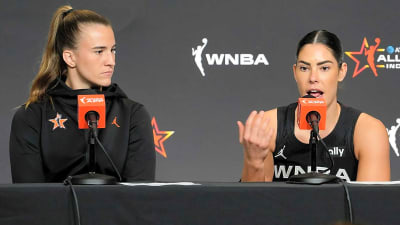
On the ever-present quest for a DNA change, the Toronto Maple Leafs’ offseason has gotten off to a slower start. It should be noted that championships are never earned in the offseason, and often many of the biggest deals of free agency’s opening days fall short of living up to the hype. For the free agent skeptics, a quieter start for the Leafs shows some needed restraint. For those expecting fireworks as the team loses talent, the work so far is underwhelming, perhaps with GM Brad Treliving coming up short.
The truth is that the Leafs have bolstered the middle of their forward group, as well as some potential call-up depth, with some recent moves. There might yet be a bigger splash on the horizon as the Leafs search for top-six forwards continues, but the Leafs are making strides in a key area. By investing more in the middle of the roster, the Leafs can build a different collective identity.
One might think of it as a step back in top-six talent in favour of a stronger top twelve group, perhaps one that extends further into the AHL. The Leafs are transitioning into an older team, but a lot of the youth on the roster bring some offensive upside. The upward mobility of the forward group organizationally provides some level of skill. While it might be hopeful that all the young players progress to their highest potential, at the very least, this lineup philosophy will see that they are more supported when they do so.
Checking line
One of the most important pieces of supporting a centre duo of Auston Matthews and John Tavares is having a third line to establish themselves as a checking line. At centre, Nic Roy joins as a suitor, though the Leafs did recently add Scott Laughton as well. Hopefully, an offseason helps Laughton get back to his Philadelphia form, as he was rather disappointing in the blue and white last year.
Roy is a bit bigger, a right shot, and two years younger. Both have a fairly similar upside offensively, perhaps 15 goals and 35 points. Comparing the two is only so useful, while deploying them is another issue altogether. Perhaps, playing them on a line together might form a foundation for a checking line. Neither Roy nor Laughton sports high-end face-off win percentages, so together they might shield each other from weak-side draws. The duo has a lot of size, grit, and defensive focus, but lacks some puck skills.
Maccelli
Meanwhile, the Leafs were also able to acquire an intriguing member of the potential checking line, in Mattias Maccelli. Though Maccelli is entering his age-25 season and has produced offensively, his ideal usage might be on a checking line. After two strong seasons with heavy defensive usage as a member of the Arizona Coyotes, Maccelli was able to put up impressive offensive totals. Things did not go well for the Utah Mammoth, as Maccelli’s production declined in a more sheltered offensive role.
Maccelli’s best seasons came on a line with a big defensive centre, either Nick Bjugstad or Jack McBain, and a stout and intense wingmate, like Josh Doan. Roy and Laughton fit a lot of those criteria, as Maccelli’s passing and transition skills help clunkier linemates up the ice and into scoring positions. Despite his skill, youth, and offensive upside, Maccelli gives the Leafs a lot as a member of a checking line.
His minutes might become expanded on either special teams unit, but Maccelli provides a lot of similar offensive elements as Max Domi. Being a playmaker who can handle heavy defensive usage is an extremely valuable piece. There is a chance that Maccelli is so good that he commands top-six minutes outright, which, of course, would be a good thing. Still, the hope might be that Domi can handle a top-six role while Maccelli sets the tone on the checking line.
Cowan
How do the Leafs go about replacing Mitch Marner? They might have some other options to replace some of his contributions on aggregate. Obviously, Auston Matthews, Matthew Knies, and Max Domi have combined to be an effective and thematic “Arizona Line” in the past. Easton Cowan joins as a similar player, though his being ready for the NHL is not to be taken for granted. Maccelli joins Domi and Cowan as potential options to replace a lot of the playmaking and transition ability. An unsigned RFA, Nick Robertson, might be at his best used in a scoring role. The upside of this organizational forward group is on the offensive end.
Defensive centre youth
An understated addition for the Leafs is Benoit-Olivier Groulx. Although he spent the entire last season in the AHL, and his production was not particularly impressive, the former Anaheim Duck finished second on his team in scoring despite playing only 47 games. His NHL track record does not stand out either, but he played only limited minutes in a defensive role for an overmatched team. While he is older for a prospect at 25 years old, it is a low gamble bet for the Leafs to add Groulx.
The Leafs were also able to add some youth through NCAA free agents, as Luke Haymes and Jacob Quillan joined the team. Both should be expected to play in the AHL this season, but give some reasonable centre depth. Behind Matthews, Tavares, Roy, Laughton, Groulx, and David Kampf, the youth and depth are important in case of injuries, which always happen. Jayme and Quillan both have some defensive traits that could help them take hold of a spot lower in the lineup if needed.
Big picture
Thanks to some friendly deals for Tavares and Knies, the Leafs still have some cap space to work with, a conservative estimate of $4.5M as it stands. Certainly, more moves are on the way, but the Leafs have been able to injury-proof their structure. Max Pacioretty, for example, is a forward who can still help the Leafs.
The loss of talent is obvious, but fans should not be too quick to write off the Leafs new look. After all, the concept of four highly paid forwards had proven ineffective. Now with only two highly paid forwards, not to mention some extra cap space, the Leafs will have new trade markets open to them. The Leafs will have a chance to buy low on talent with more cumbersome contracts, though the time to get value on salary cap dump trades is wearing thin. After the Vladimir Tarasenko trade, it’s obvious: Cap space itself is an asset.
The Leafs’ path to an improved team remains narrow, but at the very least, the concept of the team has shifted. Instead of relying on the core four, the Leafs have become a more collective and cohesive group. Looking over the past two seasons under Treliving as a whole, the Leafs have become far more physical and defensive. A deeper and more even roster lends itself to that identity, and should help the focus of the returning players to commit to the team’s emerging identity.
More must-reads:
- Flyers first-round pick expected to commit to Michigan State
- Baker Mayfield stands by Brent Venables ahead of crucial 2025 season
- The 'Single-season sack leaders by NFL team' quiz
Breaking News
Trending News
Customize Your Newsletter
 +
+
Get the latest news and rumors, customized to your favorite sports and teams. Emailed daily. Always free!








